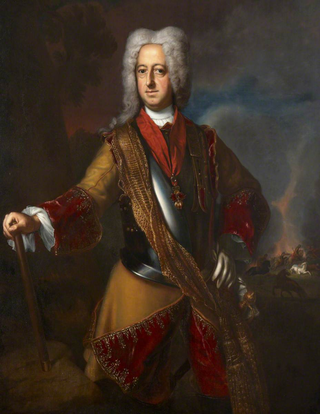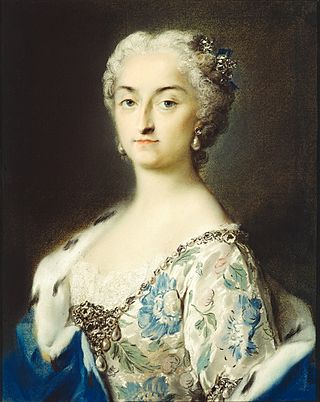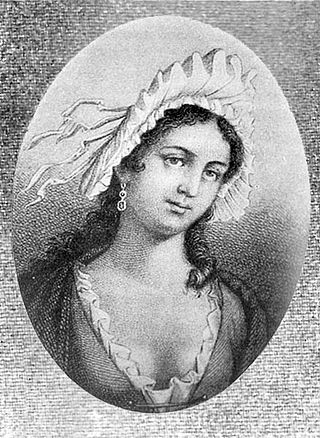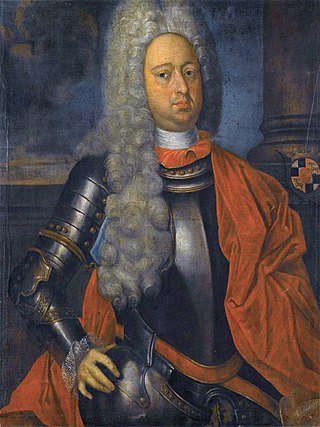Anna Aloysia Maximiliane von Lamberg
Last updated
Anna Aloysia Maximiliane Louise von Lamberg (? - died 28 June 1738) was an Austrian countess who was successively the mistress of Augustus II the Strong, King of Poland, and Aleksander Benedykt Sobieski. She is known to history as Countess Esterle.
Countess Maximiliane of Lamberg was the daughter of an Austrian count, Kaspar Friedrich von Lamberg-Kunstadt, and his first wife, Marie Františka Terezie Hýzrlová z Chodů, [1] a Czech noblewoman. [2] [ better source needed ] In 1695 she married Graf Franz Michael Hiserle (Esterle) von Chodau (Czech : Hýzrle z Chodů ).
She became the mistress of Augustus II the Strong in either 1696, with the affair lasting until 1699, or 1704 (the latter date favoured by the author of Sex with Kings [3] ). Her first husband divorced her in 1697, and in 1698 she married graf Gustav Hanibal von Oppersdorff (Oppersdorf). On 1 November 1698, she gave birth to a son, graf von Oppersdorf, whose father was supposedly Augustus II. [4] The child died soon after birth. Her relationship with Augustus II ended when the "playboy king" discovered that Maximiliane had been having affairs with several gentlemen at court; she was given 24 hours to leave the country. [3]
Later, in Wrocław, she became the mistress of Aleksander Benedykt Sobieski, who had been Augustus's rival in the 1697 election for the Polish throne.
She died on 28 June 1738 in Wrocław. Her husband, Graf von Oppersdorff (Oppersdorf), died on 29 December 1744 in Kostelec nad Orlicí.
Related Research Articles

Maximilian II, also known as Max Emanuel or Maximilian Emanuel, was a Wittelsbach ruler of Bavaria and a Prince-elector of the Holy Roman Empire. He was also the last governor of the Spanish Netherlands and Duke of Luxembourg. An able soldier, his ambition led to conflicts that limited his ultimate dynastic achievements.

Augustus II, most commonly known as Augustus the Strong, was Elector of Saxony from 1694 as well as King of Poland and Grand Duke of Lithuania in the years 1697–1706 and from 1709 until his death in 1733. He belonged to the Albertine line of the House of Wettin.

Theresa Kunegunda, was a Polish princess, Electress of Bavaria and of the Electorate of the Palatinate. By birth she was member of the House of Sobieski and by marriage member of the House of Wittelsbach. She also served as Regent of the Palatinate in 1704–05.

Maria Josepha of Austria was the Queen of Poland and Electress of Saxony by marriage to Augustus III. From 1711 to 1717, she was heir presumptive to the Habsburg Empire. Her sister Maria Amalia became Electress of Bavaria.

Aleksander Benedykt Stanisław Sobieski was a Polish prince, nobleman, diplomat, writer, scholar and the son of John III Sobieski, King of Poland, and his wife, Marie Casimire Louise de la Grange d'Arquien.

Głogówek is a small historic town in southern Poland. It is situated on the Osobloga River, in Opole Voivodeship of the greater Silesian region. The city lies approximately 35 kilometres from Opole, the capital of the voivodeship, and is about 10 km (6 mi) from the Czech border. The name of the city comes from the Polish word głóg, meaning hawthorn. The plant was abundant in the area when the city was founded. The town is well known for its preserved medieval core, market square and many architectural monuments.

Anna Karolina Orzelska was a Polish szlachcianka (noblewoman) and an adventuress. Born as an illegitimate daughter of August II the Strong, Elector of Saxony and King of Poland, by Henriette Rénard she became Hereditary Duchess of Schleswig-Holstein-Sonderburg-Beck by marriage.

Ursula Katharina of Altenbockum, divorced Princess Lubomirska, married Duchess von Württemberg-Winnental , later Imperial Princess of Teschen, was a Polish-German noblewoman and mistress of Augustus II the Strong, King of Poland and Elector of Saxony, in 1700-1705. In 1722 she married Prince Frederick Louis of Württemberg-Winnental.

Ana Katharina (Henriette) Rénard, was a mistress of Augustus the Strong, King of Poland and Elector of Saxony and mother of his daughter, the later Countess Anna Karolina Orzelska.
Maria Anna Katharina Rutowska (1706–1746) was a Polish noblewoman.

Countess Amalie Sophie Marianne von Wallmoden-Gimborn, Countess of Yarmouth, born Amalie von Wendt was the principal mistress of King George II from the mid-1730s until his death in 1760. Born into a prominent family in the Electorate of Hanover, and married into another, in 1740 she became a naturalised subject of Great Britain and was granted a peerage for life, with the title of "Countess of Yarmouth", becoming the last royal mistress to be so honoured. She remained in England until the death in 1760 of King George II, who is believed to have fathered her second son, Johann Ludwig, Reichsgraf von Wallmoden-Gimborn. She returned to Hanover for the rest of her life, surviving the king for nearly five years.

The House of Lamberg is the name of an ancient Austrian noble family, whose members occupied significant positions within Holy Roman Empire and later in the Austro-Hungarian Empire.

Elżbieta Helena Sieniawska, née Lubomirska, was a Polish noblewoman, Grand Hetmaness of the Crown, and a renowned patron of the arts.

Hrabina Cosel is a 1968 Polish film directed by Jerzy Antczak. The film is based on Józef Ignacy Kraszewski’s novel Hrabina Cosel, a historical romance set in the court of Augustus the Strong, the first of the two Saxon kings of Poland, at the turn of the 17th to 18th century.

Ferdinand Charles Gobert, Graf von Aspremont-Lynden-Reckheim (1689–1772), was a soldier, who served in the Low countries for the Habsburgs.

Countess Johanna Sophia of Hohenlohe-Langenburg was a German noblewoman, by birth member of the House of Hohenlohe and by marriage Countess of Schaumburg-Lippe.

Friedrich Wilhelm of Hohenzollern-Hechingen was the fourth Prince of Hohenzollern-Hechingen and was also an imperial Field Marshal.
Marie Eleonore of Dietrichstein, was a German noblewoman by birth member of the House of Dietrichstein and by her two marriages Countess of Kaunitz and Oppersdorf.
Królewicz was the title given to the sons and daughters of the king of Poland, later the Polish–Lithuanian Commonwealth. It was similar in its distinctiveness to the Spanish and Portuguese title of infante, also reserved to the children of the monarch. Though, it was used only to denote one's status as a King's child. Królewicz and królewna has no direct equivalent in other languages and was translated to the English prince and German prinz, like dynasts of a royal house. Królewicze since the 16th century could not also be regarded as and equivalent to the princes of the blood, because the Polish monarchy was not hereditary since 1573, when after the death of the last Jagiellon king, future Henry III of France was elected. In official Latin titulature children of Polish kings were often styled as Poloniae princeps or princeps Poloniae, meaning Prince/ss of Poland or Polish prince/ss. In more official way, the full style of sons of monarchs was Dei Gratia regius princeps Poloniae et Lithuaniae for the sons.

Sophia Charlotte von Kielmansegg, Countess of Darlington and Countess of Leinster (1675–1725) was a German-born courtier. A half-sister of George I of Great Britain, to whom she was close, she moved to England in 1714 shortly after the Hanoverian succession, where she became an influential figure of his court.
References
- ↑ cs:Hýzrlové z Chodů
- ↑ Marek, Miroslav. "lamberg/lamberg7.html". Genealogy.EU.[ self-published source ]
- 1 2 Herman, Eleanor, Sex with Kings, New York: HarperCollins, 2004. ISBN 0-06-058543-9
- ↑ "Hrabina Anna Konstancja Cosel". Archived from the original on 11 March 2013. Retrieved 13 February 2008.
Text is available under the CC BY-SA 4.0 license; additional terms may apply.
Images, videos and audio are available under their respective licenses.